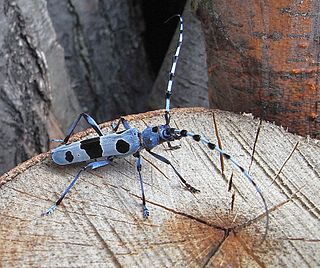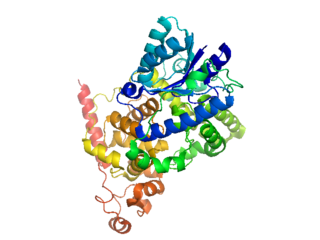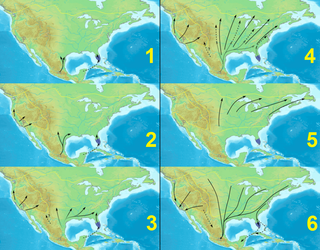
A circadian rhythm, or circadian cycle, is a natural, internal process that regulates the sleep–wake cycle and repeats roughly every 24 hours. It can refer to any process that originates within an organism and responds to the environment. These 24-hour rhythms are driven by a circadian clock, and they have been widely observed in animals, plants, fungi and cyanobacteria.

Antennae, sometimes referred to as "feelers", are paired appendages used for sensing in arthropods.

The suprachiasmatic nucleus or nuclei (SCN) is a small region of the brain in the hypothalamus, situated directly above the optic chiasm. It is the principle circadian pacemaker in mammals and is necessary for generating circadian rhythms. Reception of light inputs from photosensitive retinal ganglion cells allow the SCN to coordinate the subordinate cellular clocks of the body and entrain to the environment. The neuronal and hormonal activities it generates regulate many different body functions in an approximately 24-hour cycle.
A circadian clock, or circadian oscillator, is a biochemical oscillator that cycles with a stable phase and is synchronized with solar time.

Cryptochromes are a class of flavoproteins found in plants and animals that are sensitive to blue light. They are involved in the circadian rhythms and the sensing of magnetic fields in a number of species. The name cryptochrome was proposed as a portmanteau combining the chromatic nature of the photoreceptor, and the cryptogamic organisms on which many blue-light studies were carried out.

CLOCK is a gene encoding a basic helix-loop-helix-PAS transcription factor that is known to affect both the persistence and period of circadian rhythms.

The PER3 gene encodes the period circadian protein homolog 3 protein in humans. PER3 is a paralog to the PER1 and PER2 genes. It is a circadian gene associated with delayed sleep phase syndrome in humans.

Aryl hydrocarbon receptor nuclear translocator-like protein 1 (ARNTL) or brain and muscle ARNT-Like 1 (BMAL1) is a protein that in humans is encoded by the ARNTL gene on chromosome 11, region p15.3. It's also known as BMAL1, MOP3, and, less commonly, bHLHe5, BMAL, BMAL1C, JAP3, PASD3, and TIC.
In molecular biology, an oscillating gene is a gene that is expressed in a rhythmic pattern or in periodic cycles. Oscillating genes are usually circadian and can be identified by periodic changes in the state of an organism. Circadian rhythms, controlled by oscillating genes, have a period of approximately 24 hours. For example, plant leaves opening and closing at different times of the day or the sleep-wake schedule of animals can all include circadian rhythms. Other periods are also possible, such as 29.5 days resulting from circalunar rhythms or 12.4 hours resulting from circatidal rhythms. Oscillating genes include both core clock component genes and output genes. A core clock component gene is a gene necessary for to the pacemaker. However, an output oscillating gene, such as the AVP gene, is rhythmic but not necessary to the pacemaker.
Bacterial circadian rhythms, like other circadian rhythms, are endogenous "biological clocks" that have the following three characteristics: (a) in constant conditions they oscillate with a period that is close to, but not exactly, 24 hours in duration, (b) this "free-running" rhythm is temperature compensated, and (c) the rhythm will entrain to an appropriate environmental cycle.
Steven M. Reppert is an American neuroscientist known for his contributions to the fields of chronobiology and neuroethology. His research has focused primarily on the physiological, cellular, and molecular basis of circadian rhythms in mammals and more recently on the navigational mechanisms of migratory monarch butterflies. He was the Higgins Family Professor of Neuroscience at the University of Massachusetts Medical School from 2001 to 2017, and from 2001 to 2013 was the founding chair of the Department of Neurobiology. Reppert stepped down as chair in 2014. He is currently distinguished professor emeritus of neurobiology.

KaiC is a gene belonging to the KaiABC gene cluster that, together, regulate bacterial circadian rhythms, specifically in cyanobacteria. KaiC encodes for the KaiC protein, which interacts with the KaiA and KaiB proteins in a post-translational oscillator (PTO). The PTO is cyanobacteria master clock that is controlled by sequences of phosphorylation of KaiC protein. Regulation of KaiABC expression and KaiABC phosphorylation is essential for cyanobacteria circadian rhythmicity, and is particularly important for regulating cyanobacteria processes such as nitrogen fixation, photosynthesis, and cell division. Studies have shown similarities to Drosophila, Neurospora, and mammalian clock models in that the kaiABC regulation of the cyanobacteria slave circadian clock is also based on a transcription translation feedback loop (TTFL). KaiC protein has both auto-kinase and auto-phosphatase activity and functions as the circadian regulator in both the PTO and the TTFL. KaiC has been found to not only suppress kaiBC when overexpressed, but also suppress circadian expression of all genes in the cyanobacterial genome.

Takao Kondo is a Japanese biologist and professor of biological science at Nagoya University in Nagoya, Japan. He is best known for reconstituting the circadian clock in vitro.

Monarch butterfly migration is the phenomenon, mainly across North America, where the subspecies Danaus plexippus plexippus migrates each summer and autumn to and from overwintering sites on the West Coast of California or mountainous sites in Central Mexico. Other subspecies perform minor migrations or none at all. This massive movement of butterflies has been called "one of the most spectacular natural phenomena in the world".
kaiA is a gene in the "kaiABC" gene cluster that plays a crucial role in the regulation of bacterial circadian rhythms, such as in the cyanobacterium Synechococcus elongatus. For these bacteria, regulation of kaiA expression is critical for circadian rhythm, which determines the twenty-four-hour biological rhythm. In addition, KaiA functions with a negative feedback loop in relation with kaiB and KaiC. The kaiA gene makes KaiA protein that enhances phosphorylation of KaiC while KaiB inhibits activity of KaiA.
The Society for Research on Biological Rhythms (SRBR) is an international chronobiological research society with three key goals: (1) to promote the advancement and dissemination of basic and applied research in all aspects of biological rhythms (2) to enhance the education and training of students and researchers in the field (3) to foster interdisciplinary communication and an international exchange of ideas. The society holds biennial meetings and informal gatherings, and participates in peer-reviewed science and evidence-based policy making. It is one of four prominent existing Chronology Research Societies and one of the 14 societies that make up The World Federation of Societies for Chronobiology. The organization is currently composed of 1,000 scientists and clinicians dedicated to studying biological rhythms and their impact. The society has its own official journal, the Journal of Biological Rhythms. Through its journal and meetings the society engages scientists of all backgrounds and nationalities. It advocates the need for funding in research areas in biological rhythms such as sleep and supports other research efforts such as the National Institutes of Health and National Science Foundation.
Transcription-translation feedback loop (TTFL) is a cellular model for explaining circadian rhythms in behavior and physiology. Widely conserved across species, the TTFL is auto-regulatory, in which transcription of clock genes is regulated by their own protein products.
The food-entrainable oscillator (FEO) is a circadian clock that can be entrained by varying the time of food presentation. It was discovered when a rhythm was found in rat activity. This was called food anticipatory activity (FAA), and this is when the wheel-running activity of mice decreases after feeding, and then rapidly increases in the hours leading up to feeding. FAA appears to be present in non-mammals (pigeons/fish), but research heavily focuses on its presence in mammals. This rhythmic activity does not require the suprachiasmatic nucleus (SCN), the central circadian oscillator in mammals, implying the existence of an oscillator, the FEO, outside of the SCN, but the mechanism and location of the FEO is not yet known. There is ongoing research to investigate if the FEO is the only non-light entrainable oscillator in the body.

Christine Merlin is a French chronobiologist and an associate professor of biology at Texas A&M University. Merlin's research focuses on the underlying genetics of the monarch butterfly circadian clock and explores how circadian rhythms modulate monarch behavior and navigation.
Raleighplots, or Rayleigh plots, are statistical graphics that serve as graphical representations for a Raleigh test that map a mean vector to a circular plot. Raleigh plots have many applications in the field of chronobiology, such as in studying butterfly migration patterns or protein and gene expression, and in other fields such as geology, cognitive psychology, and physics.









